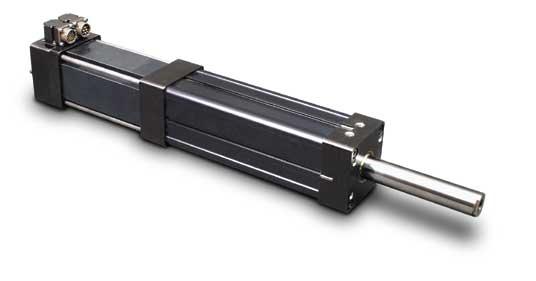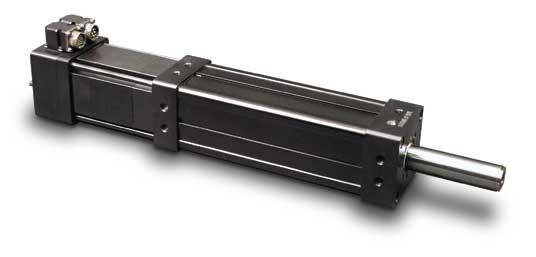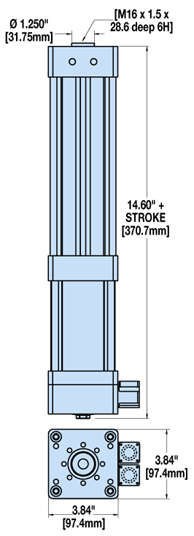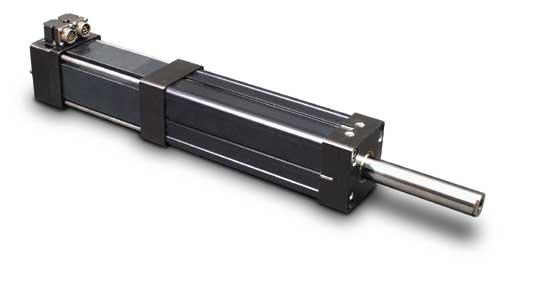Tolomatic HT Actuator by Tolomatic Axidyne Electric Motion Control

Manufacturer: Tolomatic Axidyne Electric Motion Control
- ZERO-MAINTENANCE, Factory lubricated for entire cycle life
- INTEGRATED ACTUATOR/MOTOR/FEEDBACK For optimized unit length, force, speed and performance
- NO WATER OR FORCED COOLING REQUIRED for most weld schedules
- 3-PHASE, BRUSHLESS SERVO MOTOR WITH SKEWED WINDINGS, for reduced cogging
- ROTATABLE MS STYLE ELECTRICAL CONNECTORS AND REAR HOUSING for orientation within any gun or robot connectors
- COMPACT PACKAGE fits most pneumatic cylinder footprints
| ADVANTAGES OF TOL-O-MATIC’S WELDING ACTUATOR vs PNEUMATIC ACTUATOR | ||
| feature | ELECTRIC SERVO WELDING ACTUATOR | PNEUMATIC WELDING ACTUATOR |
| ACTUATOR SERVICE LIFE | Very good to excellent, depending upon welding actuator type and distance traveled under load. Over 6,000,000 welds achieved with ball screws, and +12,000,000 with roller screws. | Acceptable if compressed air filtration and lubrication adequate; usually less than 3,000,000 welds achieved with preventative maintenance. |
| MAINTENANCE REQUIREMENTS | Welding actuator has zero maintenance. | Frequent, either cylinder rebuilding or replacement. |
| SOFT-TOUCH WELDING CONTROL | Easy to achieve--the #1 desired feature mentioned most often by end-users. Position and speed are controlled for rapid closing, slowing to a soft touch speed before tips come in contact with part. Reduces force on part and weld gun. | Repeatable performance difficult to maintain; tips contact part at full speed, generating a high impact on both part and weld gun. Pneumatic welding system enhancements (proportional and cushioning controls) do not approach servo performance. |
| COST OF USE | Due to increased energy efficiency (+80%), cost of use vs. pneumatic actuator operation is significantly lower. Cost of use is a decided advantage of electric servo welding systems over pneumatic systems. | Expensive. Compressed air is a costly utility. At $0.05/kWh, a 1/4" leak at 100 psig costs over $8,300/year. The power transmission efficiency of compressed air systems ranges between 20% to 35%. |
| COST OF ACQUISITION | More Expensive welding actuator – but reduced life cycle costs. Payback can be less than one year. | Inexpensive; but costs more over life cycle of system. Cylinder, valves, connectors, tubing, filter-regulatorlubricator all add up. |
| INVENTORY COSTS | One gun capable of multiple force outputs - replaces several pneumatic part numbers. Reduced spare parts required. Complete gun spares reduced. | Greater inventory requirements - different cylinder required for each force requirement. Many different spare pneumatic cylinder must be kept in inventory. Different mounting requirement for each cylinder means entirevwelding gun must be kept in spare parts inventory. |
| CYCLE RATE Improved production rate/reduced cycle time | Servos move fast to point-of-work, then slow for softtouch welding. In retract mode, servos can be programmed to travel less distance, thereby reducing overall cycle time. Also, servos eliminate the need for squeeze time--signal sent when at force. | Pneumatic systems have ability to move fast, but full-open to full-close operation with "bang-bang" controls adds to cycle time. |
| WELD CAP LIFE | Weld cap life improvements range from 5% to 35%, depending upon application. | Frequent replacement; weld caps deform under full force. |
| ENVIRONMENTAL IMPACT | Minimal from every aspect: noise, contamination, and energy/power efficiency. | Noise and concentrated contaminants in exhaust air are undesirable conditions. |
| SUPPORTS MANUFACTURING FLEXIBILITY | Through weld or robot controls, servos can be easily programmed to accommodate model or tool changes. Existing 6-axis robots can be retrofitted with servos to achieve all desirable aspects of servo welding. | Pneumatic weld systems require more engineering support to accommodate |
 |  |
 |  |
 |  |
Literature
Tolomatic HT Manual
[ Download ] (936kb)
[ Download ] (936kb)



